
All categories
Featured selections
Trade Assurance
Buyer Central
Help Center
Get the app
Become a supplier

(3085 products available)

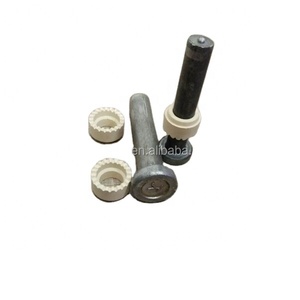



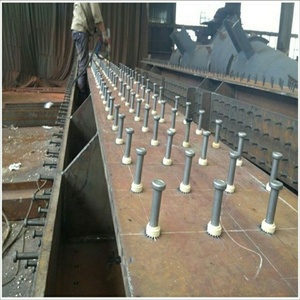

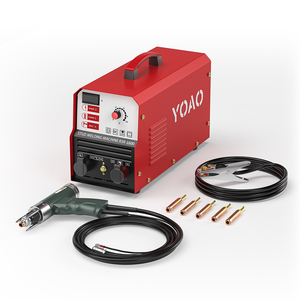






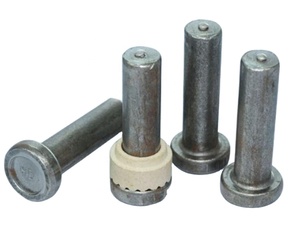
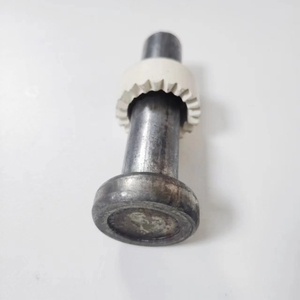


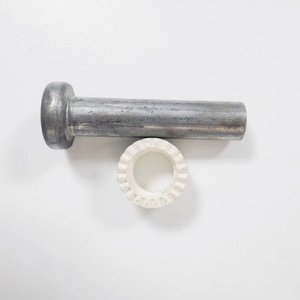
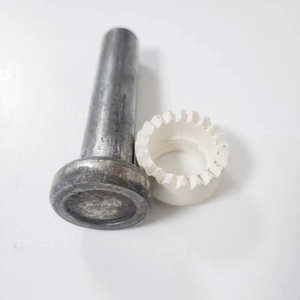




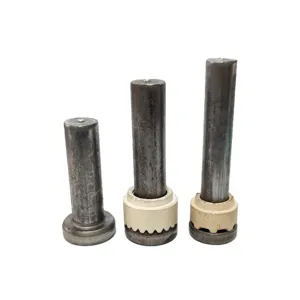

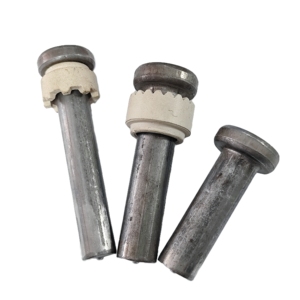









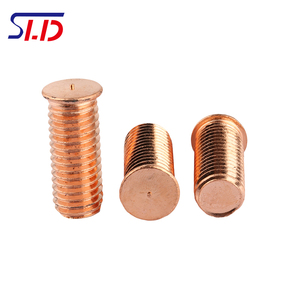

Steel weld studs have different types suitable for various welding applications. Choosing the right type is essential to ensure they meet the project's requirements and perform the desired function. Here are some common types:
Mechanical aluminum welding studs are designed for applications where high strength and mechanical fastening are required. They often feature threads or grooves on the stud surface to provide a secure bond with other materials. These studs can be fixed on an aluminium base to provide a strong joint or connection point when used in mechanical assemblies.
Resistance weld studs are particularly effective in high-volume production processes. They are typically used to attach materials like metal sheets, cables, and other electrical components. Their design, which often incorporates a flat base or pad, allows for even heat distribution during the welding process. This characteristic not only ensures a robust bond but also minimizes the time required for each weld, making it ideal for fast-paced assembly lines.
TIG (Tungsten Inert Gas) weld studs are typically used in applications that require a clean, precise, and high-strength joint. These studs can be used on an aluminium base, providing a strong connection point in mechanical assemblies. In addition, TIG welding offers minimal heat distortion, making it ideal for thin materials or situations where the substrate's integrity cannot be compromised.
MIG (Metal Inert Gas) weld studs are commonly applied in construction, automotive, and shipbuilding industries. They are particularly useful when welding thick materials or when high-speed welding is desired. MIG welding utilizes a continuous wire feed, which makes it suitable for large-scale production. Its versatility also allows it to be applied on aluminium bases or other metal materials, forming strong, permanent bonds.
Metal locking aluminum welding studs have integrated locking mechanisms or teeth. Thus, providing a secure attachment for other components. These studs are ideal for applications that require additional mechanical fastening. This includes holding rotating parts and securing gears or pulleys. Their ability to interlock with complimentary parts ensures that assemblies have increased stability and durability under dynamic loads.
Steel weld studs are widely used in many industrial settings due to their versatility and durability. They provide strong and permanent solutions for attaching materials in various applications, from construction and automotive industries to electrical systems.
In the construction industry, weld studs are commonly used in steel and concrete structures. They serve as anchors for concrete foundations, providing a solid base for structures like buildings and bridges. In addition, wear studs are often installed on steel decks before pouring concrete. This integration ensures the concrete bonds securely to the studs, creating a robust anchoring system used in constructing high-rise buildings and bridges, where load distribution is critical.
In the automotive industry, weld studs attach various components, such as exhaust systems, body parts, and electrical systems. For example, aluminium welding studs are frequently used to mount exhaust systems to the vehicle's chassis. This is because aluminium is lightweight and resistant to corrosion. Hence, it helps improve the vehicle's fuel efficiency and overall durability. Moreover, in electric vehicles, weld studs provide electrical grounding points. This ensures optimal performance of electrical systems and helps prevent rust.
Weld studs also find applications in shipbuilding. They are used to create strong, watertight bonds between steel hulls and superstructures. This includes decks and bulkheads. Moreover, because ships operate in harsh marine environments, studs are typically made from corrosion-resistant materials, ensuring the vessel's longevity. These studs are also employed in securing fittings, such as rails and platforms, enhancing the ship's structural integrity and safety during voyages.
Weld studs play a crucial role in electrical applications, particularly in securing cables and connectors to metal surfaces. They serve as attachment points for grounding, ensuring electrical systems remain stable and reliable. By providing a solid foundation for cables and connectors, aluminum welding studs enhance electrical signal transmission and reduce the risk of system failures. Moreover, their ability to withstand extreme conditions makes them ideal for use in power generation systems and industrial machinery.
In industrial machinery, weld studs are used to assemble components. They help mount gears, pulleys, and other mechanical parts securely, ensuring optimal machinery performance and longevity. Further, in maintenance-intensive environments, weld studs simplify the replacement of worn parts, thus reducing downtime and operational costs. Their ability to withstand heavy loads and extreme conditions makes them indispensable in high-demand industrial settings.
Corrosion Resistance
Corrosion resistance is critical for weld studs used in harsh conditions. These studs are made from aluminium. Thus, they provide exceptional resistance against rust and chemical degradation. This property ensures long-lasting durability for applications in marine environments, automotive industries, and construction sites exposed to moisture and corrosive elements. This feature reduces maintenance requirements and prolongs the life of the structures or components the weld studs are attached to.
Lightweight Composition
Aluminium weld studs offer a significant advantage due to their lightweight composition. They are significantly lighter than steel or other metals. This makes them ideal for applications where weight is critical. These include in the aerospace and automotive industries. The reduced weight helps improve energy efficiency. In addition, it makes transport easier and reduces overall stress on structures and vehicles without sacrificing strength or stability.
Easy Application
Aluminium weld studs allow for easy application through various welding techniques, including TIG and MIG. These techniques allow for quick attachment to a range of surfaces, whether it's a mechanical base for machinery or metal sheets in a building. This adaptability not only speeds up production processes but also minimises the equipment and expertise needed for installation. Their ease of use makes them a popular choice across multiple industries.
Versatility
Aluminium weld studs are highly versatile for multiple applications. They are ideal for assembling automotive components, building constructions, or attaching electrical systems. These studs can be tailored to suit different thicknesses and materials. This makes them adaptable to various projects and allowing for custom solutions that meet specific industrial requirements.
Preparing the Surfaces
Preparing the surfaces before installation helps in achieving a stronghold. The surfaces where the studs will be attached should be cleaned thoroughly. This ensures all paint, rust, or debris that could weaken the hold is removed. They should also be aligned properly to ensure an even attachment that can bear loads evenly.
Stud Placement
The next step is to place the weld stud on the surface. This should also be done while ensuring proper alignment with any corresponding components. When working with multiple studs, using a template can aid in maintaining consistent spacing and alignment throughout the installation process.
Tack Welding
Tack welding helps secure the stud in place as the final welding happens. A small tack weld should hold the stud firmly while the main weld is completed around it. This reduces movement and ensures a more precise final attachment.
Final Welding
Final welding should be done using the appropriate technique, either MIG or TIG. This creates a strong and stable bond between the stud and surface. It is also recommended to allow the weld to cool slowly after completion. This reduces stress on both the stud and the base material, thus enhancing the strength of the joint.
Regular Inspections
Conducting regular inspections helps in the identification of potential issues before they escalate. Inspecting weld studs also involves looking for signs of wear, corrosion, or detachment. Catching these early can prevent more significant damage or failure. One way to do this is by checking for cracks or weakness in the area surrounding each stud for a more extensive assessment.
Cleaning the Area
Cleaning around the weld studs helps in preventing corrosion and ensures the material's integrity remains good. Use a brush or cloth to remove debris, dust, or chemical residues that could lead to rusting. In situations where the studs are exposed to industrial substances, frequent cleaning is necessary to maintain the studs' condition.
Monitoring Performance
This involves regularly monitoring how the welds and accompanying components are operating together. Any unusual noises, vibrations, or movement should be reported immediately, as they could indicate weld failure or weakening. Performance monitoring also aids in scheduling timely maintenance before the equipment completely breaks down.
Repairing Damaged Studs
Repairing or replacing damaged studs is critical to maintaining operational efficiency. In case of visible damage or if the stud is loose, prompt action must be taken. Either reinforcement or replacing it is required. In some cases, a damaged stud can be reinforced with additional welding material. On the other hand, in cases where the stud is completely broken, it will need to be removed and replaced with a new one. This ensures that the structural integrity and performance of the equipment or structure remain intact throughout the process.
Material Certifications
Using aluminium weld studs made from high-grade materials is critical for ensuring project performance. Material certification guarantees that by using a stud, one is getting a part that meets internationally recognised standards for mechanical properties and chemical composition. This is especially critical when operating in stereo environments or places where mechanical loads are high. Hence, the users should go for studs with proper certification, as they ensure long-lasting and durable products.
Weld Quality
Proper welding techniques are vital for maintaining the stud's strength and stability. Users should ensure that the welding adheres to industry standards, whether using MIG, TIG, or resistance welding. This means going for studies that have been welded using appropriate techniques while ensuring even weld beads, proper penetration, and minimal spatter. These are all essential factors for creating strong and reliable welds.
Testing and Inspection
Post-production testing and inspection are one of the most important things in maintaining quality. Non-destructive testing methods like ultrasonic or radiographic testing can be used to identify internal defects without damaging the stud. Regular inspections, paired with these testing methods, can be critical in identifying potential failure points. Thus, they ensure that only safe and high-performance products are used in manufacturing.
Durability
While choosing welds, buyers should consider them with good durability. This means considering those that will go through temperature cycling and mechanical loading without degradation. Ways to go about this include using materials with good fatigue resistance and studying their performance in extreme weather conditions.
Safe Handling
While handling weld studs, manufacturers should always ensure that they wear suitable PPE, such as gloves and safety glasses. These gloves will prevent cuts and abrasions, while safety glasses will protect from flying debris. Also, when moving studs around, one should ensure that he uses proper lifting techniques to avoid straining his back, especially when carrying multiple studs at once.
Work Area Safety
Keeping work areas free of clutter and hazardous materials is quite critical while handling welds. This minimises the risk of slips, trips, and falls, which can lead to severe injuries. Moreover, ensuring proper ventilation, mainly when performing welding near the studs, also reduces the accumulation of harmful fumes that could adversely affect a person's well-being. Ventilation fans and respirators are some of the most commonly used equipment that helps improve ambient air quality.
Emergency Preparedness
Having a good first aid kit and understanding basic first aid procedures is very critical to a company that handles aluminium welding studs. This kit should contain bandages, antiseptic wipes, and other essential materials for treating minor cuts or burns. In cases where major accidents have happened, one has to call emergency medical services to get professional attention. Moreover, burn accidents can also occur during welding. So, companies need to know several ways to reduce or control burns. One of the ways is by ensuring that they have fire extinguishers near the welding area. The other one is by ensuring they first properly store flammable materials before they catch fire.
Proper Training
Operating welding equipment safely demands comprehensive training for anyone undertaking the task. Proper training guarantees that workers understand operating procedures and equipment safely and effectively. In addition, operating hazards and safety precautions must be comprehensively understood. Thus, always consulting the manufacturer's guidelines and safety manuals can help prevent welding-related injuries and accidents.
A1: Weld studs are fasteners permanently attached to substrates using welding. They are usually used as anchor points to attach other elements like insulators, electrical components, or mechanical parts.
A2: Weld studs are made from many materials. Commonly, there are aluminium welding studs, stainless steel weld studs, and carbon steel weld studs. Each type is chosen based on the specific requirements of the project, such as corrosion resistance, strength, and thermal conductivity.
A3: Weld studs are applied to surfaces through various types of welding. These include MIG, TIG, and resistance welding. The technique used often depends on the type of stud, the material of the substrate, and the project’s specific requirements.
A4: Weld studs improve insulation performance by reducing thermal bridging. They provide separate paths for heat transfer, thus enhancing a material's overall insulating properties. This reduction in bridges helps maintain ambient temperature within a space, leading to increased energy efficiency.
A5: Several factors should be considered while selecting welding studs. These include the substrate material, environmental conditions, load-bearing requirements, and insulation compatibility. These considerations ensure the chosen stud type effectively meets the performance needs.